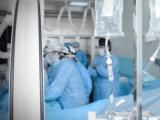The standard thinking on MERS-CoV is that it doesn't spread very easily, other than in healthcare settings with weak infection control precautions. A new study looking for transmission of the virus in the households of Saudi Arabian patients in 2013 seems to fit well with that view, though it has some limitations.
An international team of researchers looked for MERS-CoV (Middle East respiratory syndrome coronavirus) infection in 280 household contacts of 26 patients who had confirmed cases, according to their report in today's New England Journal of Medicine. They found evidence of secondary transmission in only 12 contacts, only 1 of whom actually got sick.
Other experts who looked at the study, however, raised some questions about whether all of the 12 contacts really caught the virus from the infected person in their household, as opposed to some other source.
Hunting for unrecognized infections
The research team included members from Saudi Arabia, Germany, the United States, the United Kingdom, and the Netherlands, with Christian Drosten, MD, of the University of Bonn as lead author and Ziad A. Memish, MD, of Saudi Arabia as senior author.
They observe that unrecognized transmission of MERS-CoV might explain why newly identified index cases—those in patients having no known contact with other cases—often can't be linked to contact with animals. Hence they aimed to determine the rate of silent or subclinical infections in household contacts of index case-patients.
They focused on household contacts of the 26 index patients in Saudi Arabia who were found to have MERS-CoV from Jun 4, 2013, to Nov 5, 2013. The affected households were in Riyadh (16), Dammam (3), Al-Hasa (2), Hafr Al-Batin (2), Jubail (2), and Jeddah (1).
The team used two reverse-transcriptase polymerase chain reaction (RT-PCR) assays to test throat swabs from household contacts, and they also ran serologic (serum antibody) tests. The tests were done at varying intervals after the index patients fell ill.
Because serologic tests for MERS-CoV are not yet fully validated, the authors used a three-stage process, consisting of screening with an enzyme-linked immunosorbent assay followed by an immunofluorescence test and then by virus neutralization testing. Under a decree from the health ministry, all the household contacts were required to undergo the initial testing.
The 26 index patients had a median age of 55, and 17 were male. Twenty-four of them had coexisting illnesses, and 18 died. Before hospitalization, the patients had been sick at home for an average of 6 days.
The index patients had an average of 11 household contacts each. The median age of the household contacts was much lower, at 29, and 59 of them were no more than 16 years old. Forty-eight percent of the contacts were female, and 12% had a coexisting illness.
PCR and serologic test results
The dual RT-PCR tests were positive for 7 (2%) of the 280 contacts. One of these had mild symptoms when tested, and two had had contact with camels, which can carry MERS-CoV. All seven involved samples taken within 14 days after onset of illness in the index patients.
Serologic testing identified five additional infections, all in contacts who were sampled 13 days or longer after the index patient's first symptoms. Four of these were found in the initial round of tests, and one more was identified in follow-up tests of samples taken between 2 and 6 months later. The follow-up testing was not required, and only 44 of the 280 contacts participated.
The 12 contacts who tested positive on RT-PCR or serologic assays represented 6 of the 26 households in the study. Their ages ranged from 3 to 74 years, but 11 of the 12 were under 40.
"Our findings suggest that persons in the first few decades of life without coexisting illnesses may be able to carry low levels of MERS-CoV RNA without obvious symptoms," the report says. It adds that infected but asymptomatic healthcare workers were identified in a recent MERS outbreak in Jeddah.
The authors say the low number of contacts who agreed to provide a follow-up blood sample was an important limitation of the study. They blamed the low response on the stigmatization of MERS patients and discrimination against affected families at the time.
Because of the small number of follow-up serologic tests, the authors said they may have missed some contacts who had a delayed serologic response to infection. In addition, they said they couldn't evaluate whether any of the index patients and contacts actually had common sources of MERS-CoV exposure, as opposed to the index patients passing the virus to the contacts.
Others raise questions
The latter possibility was a concern raised by Allison McGeer, MD, a microbiologist and infectious diseases consultant at Mt. Sinai Hospital in Toronto, who was consulted by the Saudi government about MERS in 2013 but was not involved in the study.
She observed that three of the contacts tested positive by RT-PCR just 4 days after illness onset in the index cases, which she found surprising: "That's a lot of people testing positive early on."
She said the median incubation period for MERS-CoV is about 5 days, and in the Al-Hasa outbreak in 2013, the median serial interval (the time between illness onset in an index case and the first secondary case) was 7.5 days.
"It's not obvious to me that these are actually cases resulting from transmission in the household," McGeer said, referring to the three patients who tested positive 4 days after the index patients got sick.
She also said she would have expected to see a larger number of secondary cases and wonders if some were missed, and added that she found the report difficult to read.
"I'm sympathetic to the difficulties of researching outbreaks and getting data, but we know that household transmission of MERS occurs, we know that asymptomatic and mild cases occur, we know people who are older likely have more severe disease—we knew all that before, and I'm not sure I know more now," McGeer said.
Another expert, Connie Savor Price, MD, chief of infectious diseases at Denver Health and Hospital, shared McGeer's concern about the difficulty of knowing whether some of the contact cases really represented secondary transmission.
"It is hard to know whether this truly represents household transmission or common exposure to the same source, which one could expect in a household setting," she said.
But she added, "Having said that, we know that healthcare settings amplify transmission of infectious diseases, and MERS-CoV is no exception. Healthcare transmission—not household transmission—has been the primary mode of human-to-human transmission in KSA [Kingdom of Saudi Arabia] in recent months. Despite the limitations, this article still supports the view that MERS-CoV doesn't spread very easily from person to person in non-healthcare settings."
Drosten C, Meyer B, Muller MA, et al. Transmission of MERS-coronavirus in household contacts. N Engl J Med 2014 Aug 28;371(9):828-35 [Abstract]




















